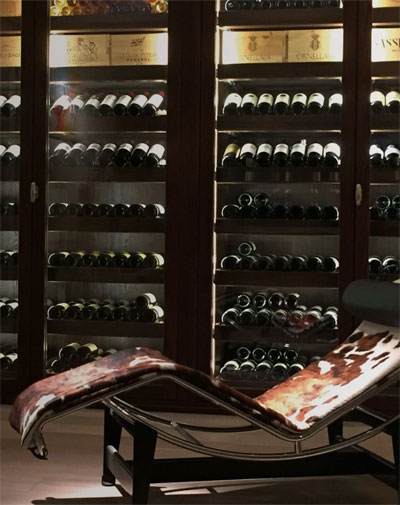
COUNTRY
Italy

REGION

GRAPE VARIETY
Cab.Sauvignon Blend

VINTAGE
2020
AVAILABLE STOCK: 5 BOTTLES

COUNTRY
Italy

REGION

GRAPE VARIETY
Cab.Sauvignon Blend

VINTAGE
2020
Country: Italy, Tuscany, Bolgheri
Grape Varieties: Cabernet Sauvignon 85%, Cabernet Franc 15%
Appellation: D.O.C. Bolgheri Sassicaia (D.O.C. Sassicaia)
First vintage: 1968
AWARDS
WINESPECTATOR / JAMES SUCKLING 96/100 "The balance and beauty to this is impressive, offering sweet, ripe currants and flowers with some crushed-stone and dry-earth undertones. Full-bodied with soft, polished tannins and a long, creamy-textured finish. It’s polished, yet concentrated. Better after 2022, but already very seductive"
Type of soils: The soils are entirely located in the territorial delimitation of the D.O.C. Sassicaia. They have different and composite morphological characteristics, characterized by a strong presence of calcareous areas rich in galestro, as well as pebbles and stones (“Sassicaia” in local dialect means soil with many stones) and also partially clay. The vineyards are located at an altitude between 100 and 400 meters above sea level, facing West/South-West.
Winemaking Notes: Selection of grapes through a sorting table to eliminate impurities and any presence of camber.Soft pressing and destemming of grapes in order not to break the skins of the berries. Subsequent spontaneous alcoholic fermentation in stainless steel vats at a controlled temperature of around 28 ° - 30 ° C (without the addition of external yeasts). The macerations lasted about 11-12 days for Cabernet Franc and 13-14 for Cabernet Sauvignon. Frequent pump-overs out door and frequent délestages during alcoholic fermentation have favored elegant musts with good structure and excellent aromatic component. The spontaneous malolactic fermentation was then carried out in stainless steel tanks and was completed by the end of November.
Ageing: At the end of malolactic fermentation, the wine was transferred to French oak barriques (one third new wood and the rest, first and second passage) where it rested for 24 months of aging period. During this time, the various masses have been kept separated according to the vineyard of origin and monitored. The blending of the selected mass one was made at the end of December, one month and a half prior to the preparation for bottling and subsequent refinement phase in the glass before marketing.

SHIPPING FEES
For orders €100,00 and
above we deliver free to
your place
For orders below €100,00 delivery
charge €10,00 within city limits.
Country: Italy, Tuscany, Bolgheri
Grape Varieties: Cabernet Sauvignon 85%, Cabernet Franc 15%
Appellation: D.O.C. Bolgheri Sassicaia (D.O.C. Sassicaia)
First vintage: 1968
AWARDS
WINESPECTATOR / JAMES SUCKLING 96/100 "The balance and beauty to this is impressive, offering sweet, ripe currants and flowers with some crushed-stone and dry-earth undertones. Full-bodied with soft, polished tannins and a long, creamy-textured finish. It’s polished, yet concentrated. Better after 2022, but already very seductive"
Type of soils: The soils are entirely located in the territorial delimitation of the D.O.C. Sassicaia. They have different and composite morphological characteristics, characterized by a strong presence of calcareous areas rich in galestro, as well as pebbles and stones (“Sassicaia” in local dialect means soil with many stones) and also partially clay. The vineyards are located at an altitude between 100 and 400 meters above sea level, facing West/South-West.
Winemaking Notes: Selection of grapes through a sorting table to eliminate impurities and any presence of camber.Soft pressing and destemming of grapes in order not to break the skins of the berries. Subsequent spontaneous alcoholic fermentation in stainless steel vats at a controlled temperature of around 28 ° - 30 ° C (without the addition of external yeasts). The macerations lasted about 11-12 days for Cabernet Franc and 13-14 for Cabernet Sauvignon. Frequent pump-overs out door and frequent délestages during alcoholic fermentation have favored elegant musts with good structure and excellent aromatic component. The spontaneous malolactic fermentation was then carried out in stainless steel tanks and was completed by the end of November.
Ageing: At the end of malolactic fermentation, the wine was transferred to French oak barriques (one third new wood and the rest, first and second passage) where it rested for 24 months of aging period. During this time, the various masses have been kept separated according to the vineyard of origin and monitored. The blending of the selected mass one was made at the end of December, one month and a half prior to the preparation for bottling and subsequent refinement phase in the glass before marketing.

SHIPPING FEES
For orders €100,00 and
above we deliver free to
your place
For orders below €100,00 delivery
charge €10,00 within city limits.






